Lo Han Chai is the perfect dish if you don’t fancy any meat but want it to be filling, with lots of various flavours and textures.
Estimated reading time: 10 minutes
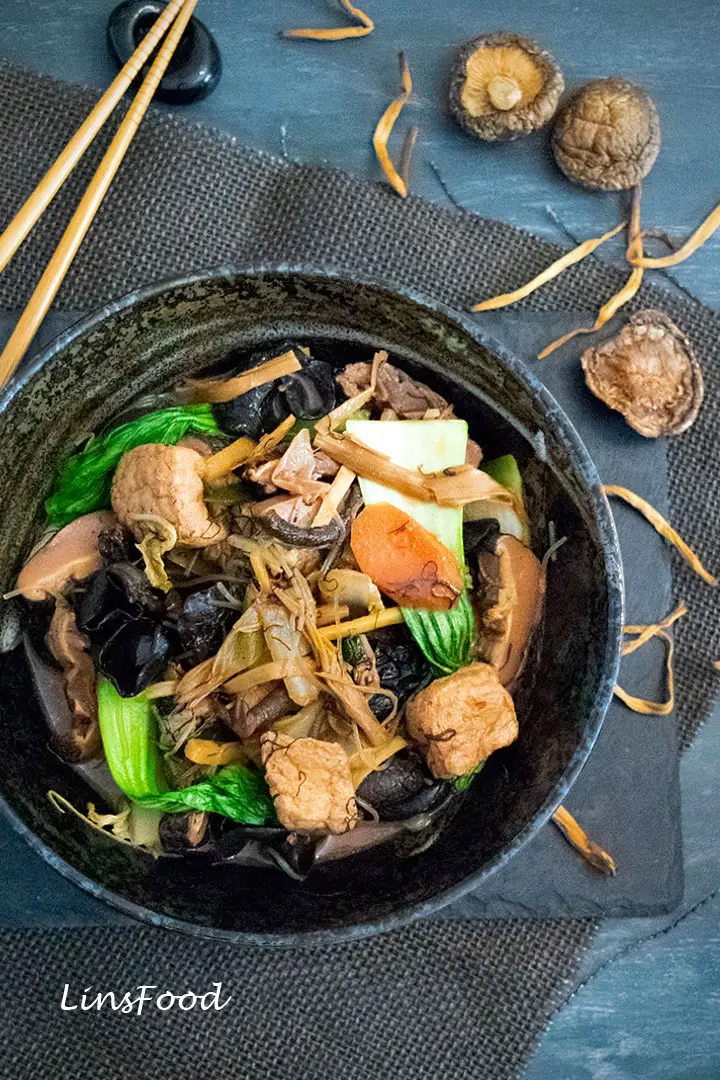
What is Lo Han Chai?
Lo Han Chai (or Jai) is a braised vegetable dish that is traditionally eaten on the first day of the Chinese New Year. This is its name in Cantonese, a Chinese dialect. In Mandarin, we call it Luo Han Zhai and its English translation is Buddha’s Delight.
This is because the word chai or jai (depends on how one spells it), refers to any and all vegetarian foods eaten by Buddhist monks.
I did a write up about the origin of Buddha’s Delight and the significance of its name over on LinsFood, if you fancy a little culture. That’s where this recipe first appeared some years ago.
As you know, the Reunion dinner on the eve of CNY is a very extravagant affair. One of the reasons lo han chai is served the next day is so that one’s body, mind and spirit can be cleansed on the first day of the new year after the big indulgence the night before.
So for many families, Buddha’s delight is a must either for breakfast or lunch on the first day of the lunar new year.
Ingredients
There are many, many combinations of ingredients that can be used to make lo han chai. To a large extent, this depends on the cook and the availability of the ingredients.
However, some are non negotiable, like the fermented bean curd, if you want to make the real thing. I’ve said this before, if you are serious about exercising your culinary muscles, then you need to source out some of these “exotic” ingredients. Think online shopping.
Or find a Chinese store, make a special trip and stock up. That’s what I used to do in the 90s, when things weren’t that easy to come by here in the UK.
Let’s take a look at many of the ingredients popularly used in cooking up lo han chai. I’ve added an asterisk to the ingredients that I like to use and that you should try and get your hands on.
The ingredients are also listed in terms of “importance”. We’ll then take a closer look at some of the more “exotic” ingredients. If you don’t habitually cook Chinese food, things like fatt choy and lily buds are going to be exotic, right?

Lo Han Chai Ingredients
- garlic* – although the traditional Buddhist monks wouldn’t have been fond of foods flavoured strongly with it (same goes for ginger and onions)
- ginger*
- spring onions (scallions)/onions*
- shiitake* – the dried ones are the preferred option here for the concentrated flavour and aroma. We also use the soaking liquid as part of the stock to stew the vegetables in Buddha’s Delight. Use fresh, if you can’t get dried.
- dried lily buds* – as its name suggests, these are lilies. They have a fruity and slightly sour aroma and flavour to them. In fact, the smell reminds me of the salted plum snack I used to love as a kid in Singapore.
- mung bean noodles* (cellophane noodles), these add a lovely texture to your lo han chai
- fried tofu puffs*
- red fermented bean curd* (or white, if you can’t get red) Read more here, on LinsFood.
- carrots*
- some sort of green vegetables* – napa cabbage, white cabbage, pak choy, snow peas
- dried wood ear mushrooms*
- fatt choy (black moss)*
- bamboo shoots
- water chestnuts
- gingko nuts*
- red dates (jujubes)*
- lotus root and seed
- dried tofu skin
- peanuts
- beansprouts
- baby corn
In the video, you don’t see me using gingko nuts and red dates. At the time of filming, my local Chinese were fresh out of them! But just follow the written instructions in the recipe card below on how to use them.
Dried Lily Flowers
Dried Lily Flowers have a slightly tart and fruity flavour. Also known as gum jum choi or golden needles, given their appearance. These are the dried petals of the day lily or Hemerocallis Citrina.
We soak these guys before using, to rehydrate them. I really love their tartness and they frequently get tossed into stir-fries and South East Asian curries.

Cellophane Noodles
Cellophane noodles or mung bean noodles become translucent and jelly-like once cooked. They can be made from mung beans, potatoes or sweet potatoes and are not usually stir-fried on their own. Instead, they are used as an ingredient to soups, stir-fries and spring rolls.
Koreans are one of the very few cultures who served these noodles as a dish. They have various names across South East Asia. I grew up calling them soo hoon or tang hoon, as opposed to bee hoon (bihun) which is rice vermicelli.
Easily found in East Asian stores. Here’s my affiliate link for it on Amazon. This is the brand I’ve been using for as long as I can remember.

Fried Tofu Puffs (Tau Pok)
I cannot live without tau pok! I use them in everything and always have some in the fridge or freezer. Fried tofu puffs are tofu cubes that have been drained of as much liquid as possible, then fried. They puff up upon frying, hence the name.
These are easily found at East Asian shops, whatever their inclination.
I promise to do diy tau pok recipe soon!
I prefer to use them in lo han chai, instead of bean curd skin.

Fermented Bean Curd (Tofu)
Fermented bean curd is tofu that’s been preserved with other ingredients like salt, rice and other flavourings. It’s also called Chinese cheese, tofu cheese or just fermented tofu. You’ll find it in white as well as red.
It has a fairly pungent aroma and lends depth, saltiness, earthiness and a hit of umami to your lo han chai and to me, is an absolute must. You will find fermented bean curd in Chinese shops and most definitely on Amazon. Here’s my affiliate link for it.
Can’t get fermented bean curd? Get your hands on dark or red miso paste and use the same amount as the bean curd in the recipe here.

Wood Ear Fungus
A very East Asian ingredient, wood ear fungus or jelly ears have a very interesting texture. They are jelly-like and are chewy once soaked. If you can’t get them, or don’t like them, leave them out of the recipe.
They are easily found in East Asian shops, in dried form.

Fatt Choy (Black Moss)
Fatt choy is very, very popular at Chinese New Year for its similarity in sound to how we wish someone happy new year, Gong Xi Fa Cai (this is in Mandarin).
- Gong Xi = congratulations
- Fa Cai = making money, becoming rich, gathering wealth, etc
- So saying Gong Xi Fa Cai is wishing lots and lots of riches upon someone, a central theme in the Lunar New Year celebration.
You can see that Fatt Choy is very similar in sound to Fa Cai, hence its popularity this time of year. Much of the food consumed during Chinese New Year has to do with this concept.
Real fatt choy is a blue-green algae (aka cyanobacteria) that grows on land in and around Gobi Desert. Harvesting it causes soil erosion and is harmful to the land. This has led the Chinese government to restrict its production, pushing up the price.
Much of fatt choy available on the market these days is a synthetic version made of starch. Since it doesn’t really contribute much in terms of flavour, it makes no difference if all you can get is the man made one.
In dried form, fatt choy looks like human hair. Once soaked, it looks like thin strands of seaweed, as you can see.
Once again, Chinese shops are your best bet for finding fatt choy. Can’t get it? Leave it out.
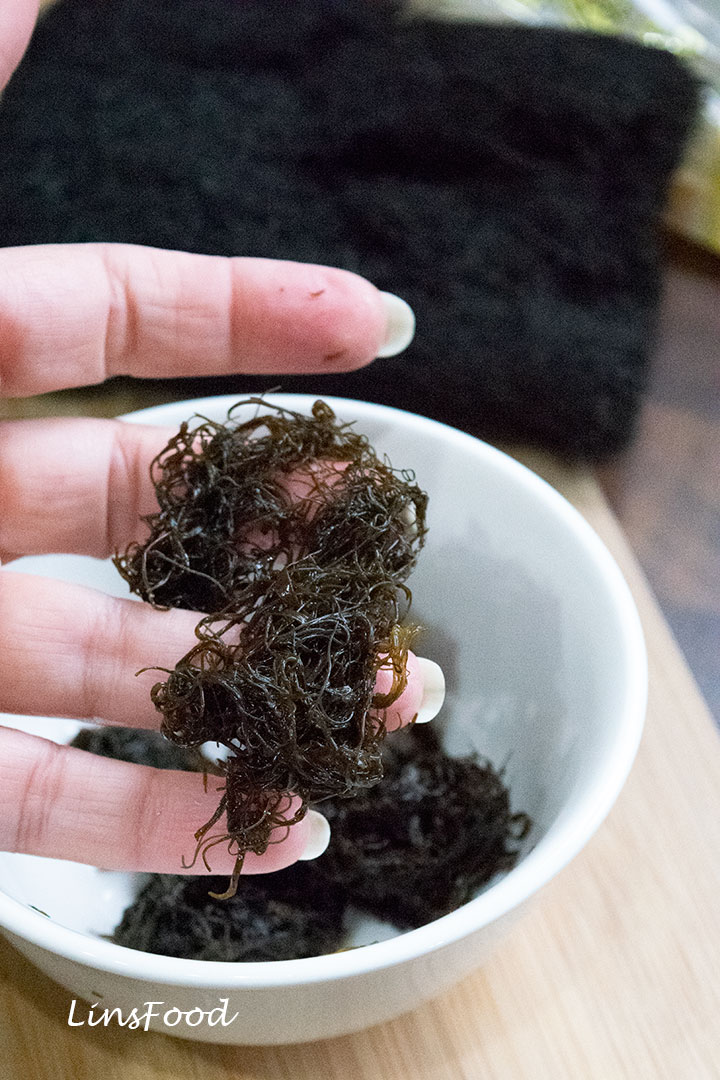
Lo Han Chai Recipe
To fully enjoy Lo Han Chai, you want to get a variety of ingredients as described above. You don’t need to get everything, but you do want an assortment of flavours and textures for the best experience.
Don’t be put off by the fairly long list of ingredients. In the recipe below, I’ve split them up into groups for a clearer picture of what you need.
As is always good practice, get all the ingredients ready, which will only take about 15 minutes, before you start soaking and cooking. Life will be less complicated that way. Trust me.
The recipe card below has check boxes, tick the ingredients off as you get them.
To cook Lo Han Chai
- We soak all the dried ingredients in very hot water. 30 minutes for the mushrooms, lily buds, red dates and black moss, 1 minute for the cellophane noodles.
- Drain the noodles and toss in sesame oil (for flavour and to stop them sticking).
- Chop up the aromatics (garlic, ginger, spring onions) and vegetables.
- Drain and chop the soaked ingredients. We save the soaking liquid from the shiitake and lily buds. Lo Han Chai is a braised vegetable dish, not a stir-fry.
- Cook it all up, which is a fairly short process, about 15 minutes.
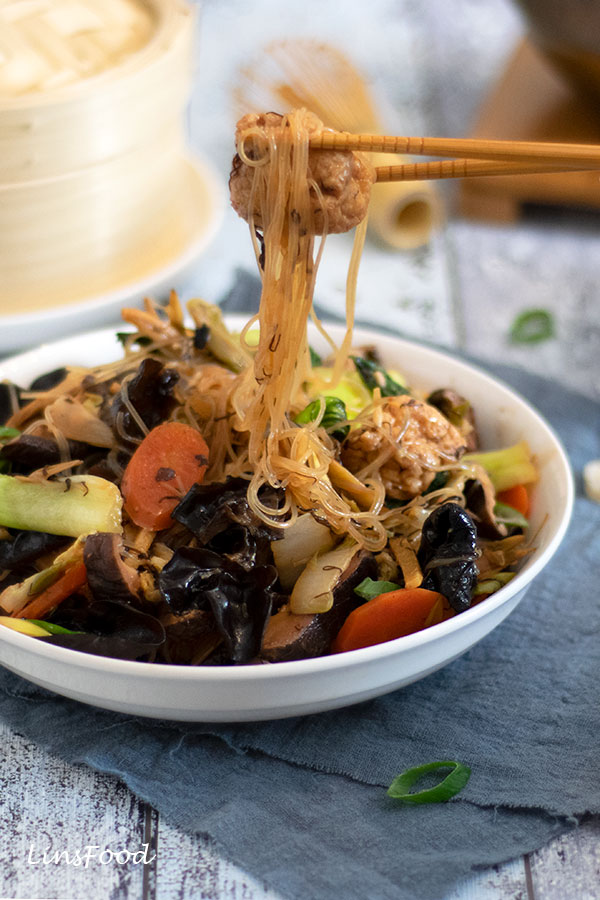
How to Serve Lo Han Chai
Treat it like a side dish and serve it with some rice. In the spirit of the dish, serve it alongside other vegetarian side dishes for a completely vegetarian meal.
However, it really is up to you. Serve it as part of an East or South East Asian meal and eat lo han chai as you would any vegetable side dish.
And that’s all there is to it. Shall we get cooking?
If you enjoy the recipe, drop me a comment and let me know. And if you are feeling like a star, don’t forget that 5-star rating! 😉 Xièxiè
If you make this recipe, post it on Instagram and tag me @azlinbloor and hashtag it #linsfood.
Lin xx
More CNY Recipes
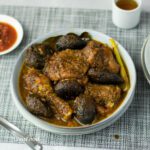

Images by LinsFoodies
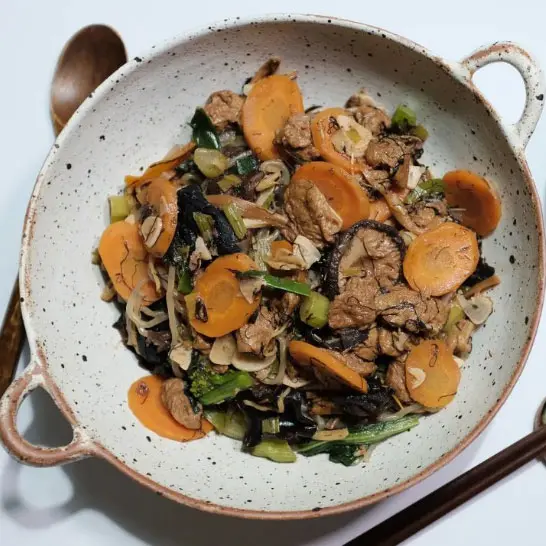

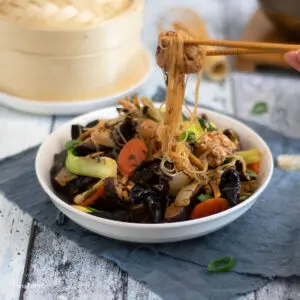
Lo Han Chai (Chinese Vegan Braised Vegetables)
Equipment
- a wok, a saute pan or a large, deep frying pan
- spatula
- bowls as needed
- strainer or colander
Ingredients
Dried Ingredients
- 60 g dried shiitake mushrooms (about 10-12)
- 10 g dried lily flowers (about a handful)
- 10 g wood ear fungus (or a handful oyster mushrooms) (about a handful)
- 3 g black moss (fatt choy)
- 10 dried red dates available in Chinese shops
- 50-60 g cellophane noodles (1 bundle)
Aromatics
- 2 cloves garlic
- 5 cm ginger
- 3 spring onions (scallions)
Vegetables
- ½ a small napa cabbage
- 2 bunches pak choi
- 1 medium carrot
Braising Liquid
- 2 Tbsp Shaoxing rice wine (or any rice wine, OR dry sherry, OR ½ tsp clear vinegar for alcohol free)
- 2 Tbsp light soy sauce
- 1 Tbsp dark soy sauce
- 1 tsp white sugar
- ½ tsp salt
- 125 ml shiitake soaking liquid
- 125 ml lily flower soaking liquid
The Rest of the Ingredients
- 1 Tbsp vegetable oil
- 3 cubes red fermented bean curd (or 5 for a stronger flavour)
- 100 g fried tofu puffs
- 60 g gingko nuts optional
- 1 Tbsp toasted sesame oil
Instructions
Soak the Dried Ingredients (for 30 minutes)
- Boil some water, and place all the dried ingredients in separate bowls. Pour the boiling water over each ingredient and leave all to soak for 30 minutes, apart from the cellophane noodles, which only needs 1 minute.
- Drain the cellophane noodles after just 1 minute, rinse in cold tap water, then toss with the 1 Tbsp of sesame oil. Set aside. This is the time to chop up all your aromatics and vegetables.
- At the end of 30 minutes, drain all the soaked ingredients, reserving the soaking liquid from the shiitake and lily flowers.
- Snip off the slightly harder ends of the lily flowers and discard.Slice the shiitake.With a pair of scissors, cut the wood ear fungus if you like. I prefer to leave them whole, even the larger ones.
Chop up the Aromatics and Vegetables (during soaking time)
- Slice the garlic, julienne the ginger and chop up the spring onions into 2.5cm (1") lengths.
- Slice the cabbage widthwise, about 2.5cm (1") wide.
- Cut off the ends of the pak choi, rinse, and leave them whole.
- Slice the carrot.
Prepare the Braising Liquid
- Mix all the ingredients together, including 125ml (½ cup) of the soaking liquid from the shiitake and lily flowers, each.
Time to Cook Lo Han Chai
- Heat the oil in a large wok on medium-high heat and fry the garlic, ginger and spring onions for 30 seconds.
- Add the carrots, lily flowers, shiitake, wood ear fungus, black moss, red dates, gingko nuts and fermented bean curd.
- Stir to mix, mashing up the bean curd as you go along. Then pour in the braising liquid. In the video, you see me adding the soy sauces and wine mix, followed by the 2 soaking liquid.Bring to a boil, then simmer for 5 minutes.
- Add pak choi and cabbage and cook for 2-3 minutes, depending on how soft you like your pak choi and cabbage.
- Add the tofu puffs and heat through for 1 minute.
- Then finally, throw in the cellophane noodles, separating the strands slightly. Stir to heat through for 1 minute. Check seasoning and add more salt, if you think it needs it. Serve up immediately. The cellophane noodles will gradually absorb the liquid in the dish.

2 thoughts on “Lo Han Chai (Chinese Vegan Braised Vegetables)”